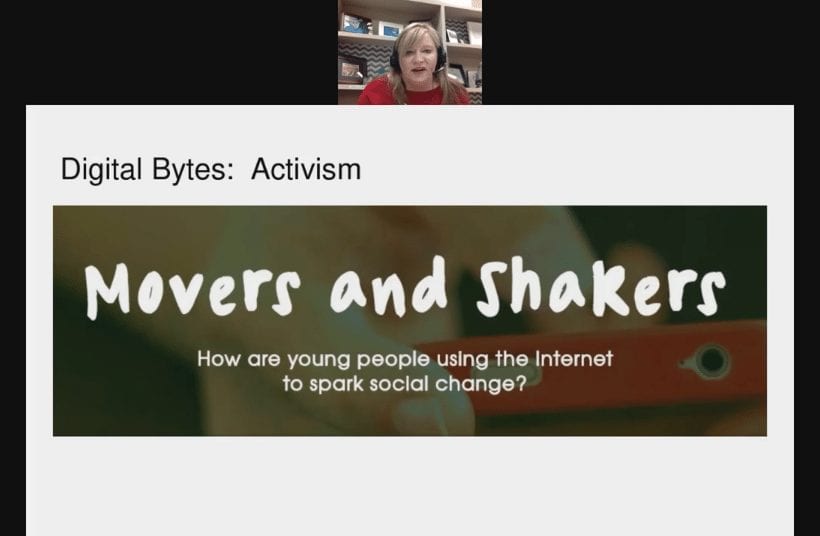Four Steps to Help Students Develop a Healthy Media Diet
With the proliferation of technology in school and at home, parents are looking for direction on how to keep their kids’ media habits in check. Librarians, who are often at the front lines of media and tech in schools, can provide that crucial guidance. The discussions shouldn’t focus on denying technology, though, said Michelle Cooper, Library Media Specialist, White Oak ISD, TX in the edWebinar “Achieving Media Balance in a Tech-Immersed World.” Instead, librarians can help families learn how to maintain a healthy balance and become good digital citizens.
Step 1 – Student Outreach: Develop and implement a digital citizenship plan that spans grades K-12; as students move up, the plan should reflect the changing needs at each level. Key topics include cyberbullying, information literacy, digital footprints, and overall Internet safety. In addition, empower students to take control of technology by asking them how they could use media in a positive manner to effect social change.
Step 2 – Parent Communication: Via school blogs, social media accounts, and the website, detail how the school is promoting good digital citizenship. Post resources, highlight successes, and create a place where students can report problems like cyberbullying.
Step 3 – Parent Education: Give parents opportunities, such as a lunch and learn, to hear from staff face-to-face about student technology use. At each meeting reiterate the school’s commitment to digital safety, provide tips and insights into the technology used at the school, offer resources parents can refer to at home, and let them ask their questions about kids and media. They may bring up topics you hadn’t thought of and should add to your program.
Step 4 – Home-School Connection: Provide students with a family media agreement and device contract to share at home. The goal is to make parents more aware of key factors, including:
- What are kids doing on their devices?
- How much time do they spend on them?
- Is the content age-appropriate?
The contract can also help families mediate conflicts, negotiate media-free zones, and agree on ratings and time-limits for content. But the agreement isn’t just for the kids.
“Another step is to walk the walk. Yes, you have signed your agreement, but let’s follow through with it,” said Cooper. “Let’s make sure that if I’m asking my kid or my student to put away their device at dinner then I’m putting mine away too. So, I’m modeling that behavior, and then [we] stop and talk about it.”
This broadcast was hosted by edWeb.net and Common Sense Education and sponsored by Symantec.
This article was modified and published by eSchool News.
About the Presenter
Teacher-librarian at White Oak ISD in Texas, Michelle Cooper, is a passionate educator and enthusiastic proponent of school libraries, technology integration, collaboration with educational professionals, and helping young people succeed. Michelle is constantly striving to improve her educational practices and create innovative learning opportunities for students and colleagues. She is committed to sharing and modeling the importance of digital citizenship with students. She serves on the TCEA Board of Directors as the Area 7 representative. She is a co-founder of #TXLchat on Twitter, which provides a forum for (but is not limited to) Texas librarians to create collaborative connections, share educational resources, and foster lifelong learning. Michelle is the 2016 TCEA Library Media Specialist of the Year, a 2017 AASL Advocacy Ambassador Finalist, a Wonderopolis Wonder Lead Ambassador, a Makey Makey Ambassador, and a Common Sense Media Ambassador, as well as a recipient of the 2016 TASL MVP Honorable Award for Excellence and the 2016 TLA Branding Iron Award for Social Media for #TXLchat. She also serves on several committees for ALA, AASL, and TLA.
Join the Community
Digital Learning & Leadership is a free professional learning community where you can share, learn, and discuss ideas and best practices to enhance teaching with technology.
Common Sense Education provides teachers and schools with free research-based classroom tools to help students harness technology for learning and life. Our K–12 Digital Citizenship Curriculum and interactive games teach students how to make safe, smart, and ethical decisions in the digital world. And our revolutionary educational rating system, Common Sense Graphite, helps educators discover, use, and share high-quality digital products that propel student learning.






Comments are closed.